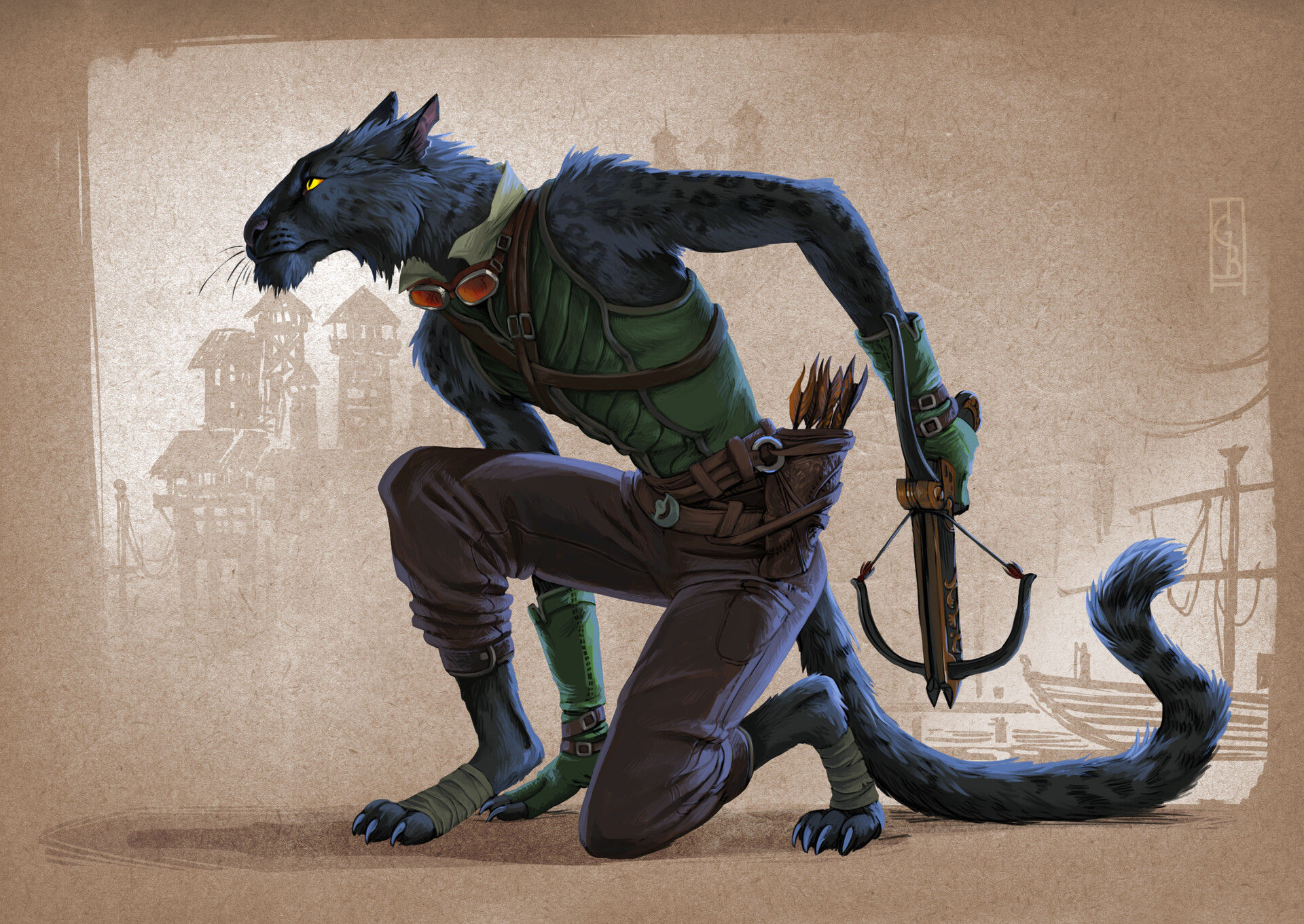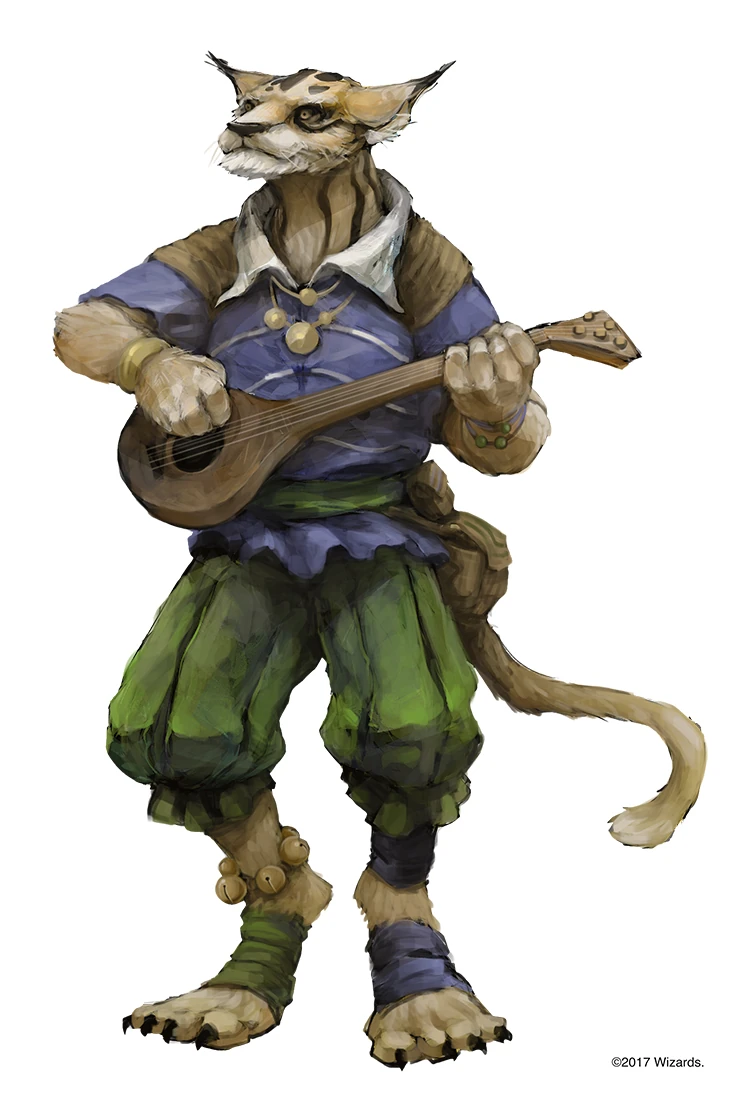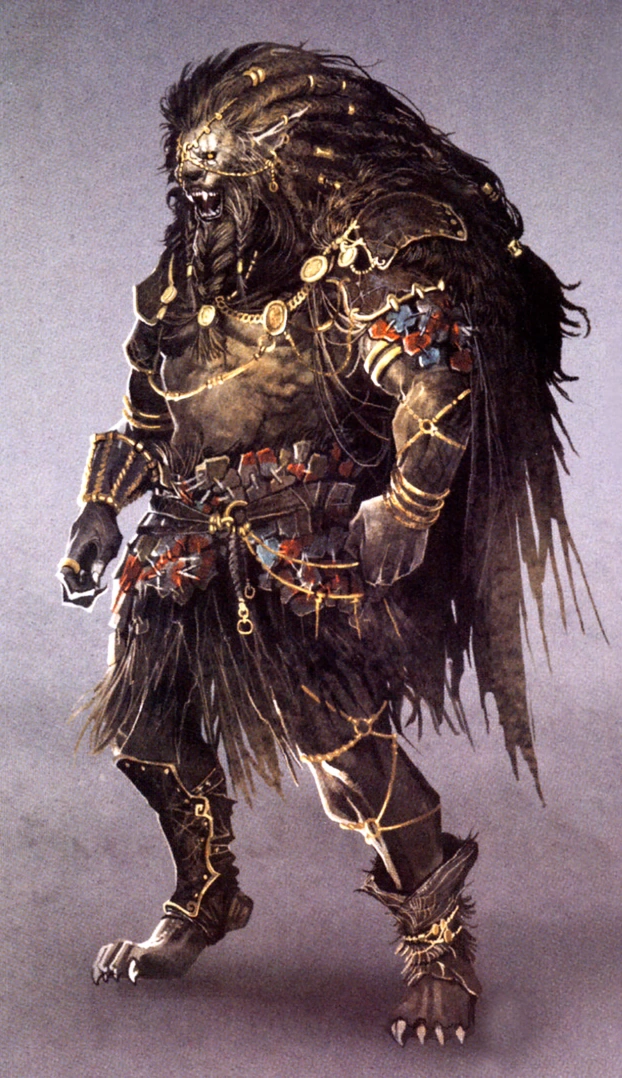Race: Tabaxi
One of the many great beast races which inhabit the world of Elysium, Tabaxi are humanoid cat-like beings that inhabit many parts of the globe. Often tall in stature, yet stealthy in pace Tabaxi have a wry wit and a hedonistic outlook, yet are fearsome on the field of battle.
Appearance
While typical Tabaxi in D&D are normally depicted as jaguar/leopard cat creatures, the most notable characteristic of the Tabaxi in Elysium is their varying feline appearance. True to the nature of being “Cat-folk”, Tabaxi in Elysium are based physically upon real-life cats, they resemble them, and the range of facial and bodily features enable them to have numerous and varied faces and body types. Some typically resemble New World mountain cats, such as lynx, bobcats, and cougars, while others display features tantamount to those of Old World cat species, including tigers and leopards, and more yet resemble domestic cats. Most Tabaxi are tall in stature and sport a very wiry yet equally strong physique. However while this body-type is typically the most common amongst the more populous Tabaxi variants like those of Wild-Cat or Bobcat appearances, other body types for other variant’s exist. For example, those that tend to resemble more Lion-like features, often sport a strong, compact body with powerful forelegs. Tiger-like Tabaxi tend to be muscular with shortened legs, strong forelimbs, broad paws, a large head and a tail that is about half the length of the rest of its body. Smaller Tabaxi, like those that resemble small house-cat’s, tend to sport a smaller skull and shorter bones, thus being of a more lithe stature compared to most. While they don’t make for typically strong Tabaxi, these ones do tend to be slightly faster and more agile than their big-boned cousins who rely mostly on brute strength as opposed to agility. .Habitat
Tabaxi are often a reclusive people who often avoid interaction with other intelligent races. However, as each Tabaxi possesses a specific feline trait, an innate curiosity that has compelled them to travel, although typical Tabaxi populations tend to be highly concentrated within the jungle regions of Elysium, Tabaxi can also be a remarkably wide-ranged people that can be found living in deserts, mesas, icy tundras, tropical reefs, wetlands, and mountainous regions. Certain types tend to congregate in certain areas and often times will overlap with one another, and as a result multiple Tabaxi types can live in one area at any given time. Typically the most dense populations can be found in the jungles of Breonai and Dhuusamira and the woodland’s of Valenwood but many can be found spread throughout the worlds on separate continents like Senko. On the continent of Arkael they can be found as far south as Sunscald and as far north as Shalepeaks, though many tend to be more of a “warm-land dwelling” variety and as such it’s rare to find them that far north.Language
Tabaxi officially have two languages. Typically going back in history, the oldest language spoken by Tabaxi known by historians appears to be a language known as Mriaer. Mriaer, also known as “Cat-Tongue”, is one of the oldest languages known in Tabaxi society and extremely hard for those not of Tabaxi heritage to pronounce. Yet surprisingly those with the ability to speak to animals who don’t speak common or do not have the abilities to do so, have interestingly also found that Mriaer is not only used by Tabaxi or is strictly Tabaxi-centric and that it is in fact a universal language that seems to be widely spread out amongst all Feline species across the world, but that each have a different dialect from the other which dictates how “heavy” the language is when spoken. The reason Mriaer is hard for people to pronounce, is because typically Mriaer is a language in which the common vocalization found in Felines, function as normal consonants, using the wide range of vocalizations cat’s typically are known for, similar in manner to that of the Click Consonant speech sounds that occur as consonants in many languages of Southern Africa and in three languages of East Africa. But while Mriaer is a common language spoken by nearly all feline species throughtout the world, Tabaxi don’t typically use Mriaer as a commonly used or day to day language, and instead use a language known as Aoddasi (o-da-see), which has a grammatical structure very similar to that of the Earthen Persian and Romani languages. With enough time and practice, many Tabaxi can learn how to talk in the same languages as other cultures, including the human language (Common), Elvish (ner) and many others. However despite this, they often still retain a degree of an accent even if their first language is Human or Elvish and not their native tongue.Naming
Typically, D&D Tabaxi are known by different names. Oftentimes, Tabaxi with solid spots were sometimes called leopard-folk and Tabaxi with rosette spots were called jaguar-folk. The way the Tabaxi pronounced their own name was also varied; the "leopard-folk" pronounced it ta-BÆK-see, and the jaguar-folk tah-BAHSH-ee, which is how to pronounce Elysium’s Tabaxi. In Roads of Elysium, Tabaxi follow a similar naming route, but one that seems more indicative to the naming conventions of how the Khajiit from Bethesda’s Elder Scrolls series typically were named. For example, in the Elder Scrolls series, both a Khajiit's appearance and physiology depend on the Lunar Lattice of Masser and Secunda during the time of its birth. As a result, these appearances can vary drastically from one breed to another, with some Khajiit resembling the common house cat, other Khajiit resembling huge bipedal jaguars, and others being almost indistinguishable from Men or Mer and with that came naming conventions indicative of a Khajiit birth. The main variants of Khajiit can be separated into four distinct groups, each depending on the phases of Nirn’s larger moon, Masser. Within the four groups are more variants which depend on the phase of Nirn's smaller moon, Secunda. The variations due to Secunda are more subtle than the variations due to Masser. Secunda's phases determine how bestial any born Khajiit appears; during its waxing phase a Khajiit appears less bestial, while during its waning phase a Khajiit will appear more bestial. For many types of “breedstock”, subtypes often had the term Raht attached to their name, translating to “large, grand, or greater”. And while the appearance of Tabaxi in Roads of Elysium is not based around the cycles of the moon, many do tend to have a term attached to their names indicative of what Breedstock or “Fur-stock” they are (cat they’re based off of). For example: while Tabaxi would be the species name and the typical name given to any known Cat-folk, the name that follows after would be the Tabaxi tongue name of the cat they are based off of. For example, Tabaxi-Ha'raj literally translates into Cat-Folk of Royalty or more simply put “King Cat or Ruler Cat”. This naming is often given to those of “Lion-Stock” as a play on the term “King of the Jungle”. For some Tabaxi, it is easier to group certain Breedstock together in naming conventions rather than to come up with a name for each individual one. For others, individual names for specific stock come more commonly, such as those for “Tiger-Stock”, which is Tabaxi-Fus, the Tabaxi word for Force, often indicative of the Tiger-stocks strength and fighting prowess. As it stands there are seventeen known "base" breeds of Tabaxi, not counting those born from the union of two seperate Fur-Stocks which create a Hybrid-Child.Occupations
Many forms of Tabaxi thrive in different job environment’s. While many tend to make excellent thieves due to their natural agility and unmatched acrobatic abilities, many are also warriors and can be hired as guard’s for a variety of different things, although this is mainly true of the Tabaxi-Fus and Tabaxi-Ha'raj stocks. In addition to their native quickness, Tabaxi have evolved to have a natural proficiency in stealth, and have the added benefit of native night vision. These skills, combined with the general tendency of humans and elves to look down on them as "beasts," lead many Tabaxi outside of their home province to become bandits or professional thieves and assassins, such as the hired assassins from many anti-governmental guilds or thieves-guilds.History
Tabaxi along with other Beast-Races are still considered little more than beast-men by many human and mer cultures. They are not usually trusted by—mostly—the Nér (men), but also by people in general. Because of the growing black market and slave trade growing in Elysium, many large stocks often find themselves forced into slavery and often times into Gladitoral fights. Because many disdain weapons in favor of their natural claws, many who organize fights between opponents and large-stock often forcibly declaw or de-fang combatants in order to entice them to use weapons instead. However those who have been declawed often do not last long in the battlefield due to the early onset arthritis that forms in their finger joints, as similar to domestic and “feral-cats”, the claws on a Tabaxi are not nails but are instead extensions of their fingers. Those who form arthritis after procedures, which are often crudely done to begin with, find holding weapons to be hard, and those who can not fight are often used as training “bait” for younger, more “green” opponents. Many do not survive, and those that do are horrifically scarred and traumatized. In addition, many Tabaxi are sometimes hunted or killed for their pelts, which are sold as typical “wild-fur” (feral) coats. Because many tended to be slaves and because it is hard to often tell “wild-fur” from “Beast-folk” due to the varying body-sizes known throughout Tabaxi, many sellers often get away with falsely advertising Tabaxi coats as “wild-fur” to avoid detection and thus the selling is widely still present in many markets both legit and blackmarket. Even despite if Slavery is outlawed. In fact for many Tabaxi Slaves, especially those bought younger due to them typically having more shiney coats compared to elders, being bought only to be killed and skinned is often the most common outcome for those who don’t survive their initial captivity.
Trivia
In Tabaxi-Ha'raj society, males are often distinguished by Mane-Type. Similar to real-world lions, Mane’s (males) with darker hair are usually sexually preferred by the females. For a Male with a dark mane is supposed to indicate greater fertility. As a result, Darker-Maned males usually tend to have a lot more courters than most.
Tabaxi, like many species of real-world cat, have penile spines. Despite this, copulation with Humans/Elves/Other species is possible though great care must be taken if the Male in the relationship happens to be a Tabaxi. Though there have been many reports throughout the Eras of children forming from these unions, there have been no well documented offspring. However because Tabaxi differ from humans and elves in their physiology, it is highly likely that any child formed from these unions IF one should form would more than likely be sterile.
Tabaxi are typically viewed as second-class citizens due to their bestial appearance. Due to stereotypes, the distrust displayed to their race makes finding an honest living difficult.
Tabaxi-Fus (Tiger-Stock) are one of the rarest of the stock-breed’s in Tabaxi society. This is because slavers and hunters often prize poaching them for fur and body parts which contribute highly to the decrease of populations in all range countries in a manner similar to that of Feral Wild Tigers. In fact hunters and slavers often state that they often kill Fus more for local consumption and trade of skins, bones and meat, in retaliation for attacks, and for excitement. Seizure data from slavery liberations often also indicates that Fus skins are the most often traded body parts, followed by claws, bones and teeth which for many are believed to give the consumer strength should they be eaten or worn, a similar situation that once befell and still does plague the Native Wolf-Folk of Arkael.
Tabaxi-Mauru or “Mauru” are the smallest of all the Tabaxi. Naturally curious, they tend to behave in a manner similar to that of Monster Hunters Palico. Typically resembling a house cat, many try to enter human society, and are often hired by locals to perform a small variety of jobs in villages and towns, from shop-keeping to farm maintenance to cooking.






Comments